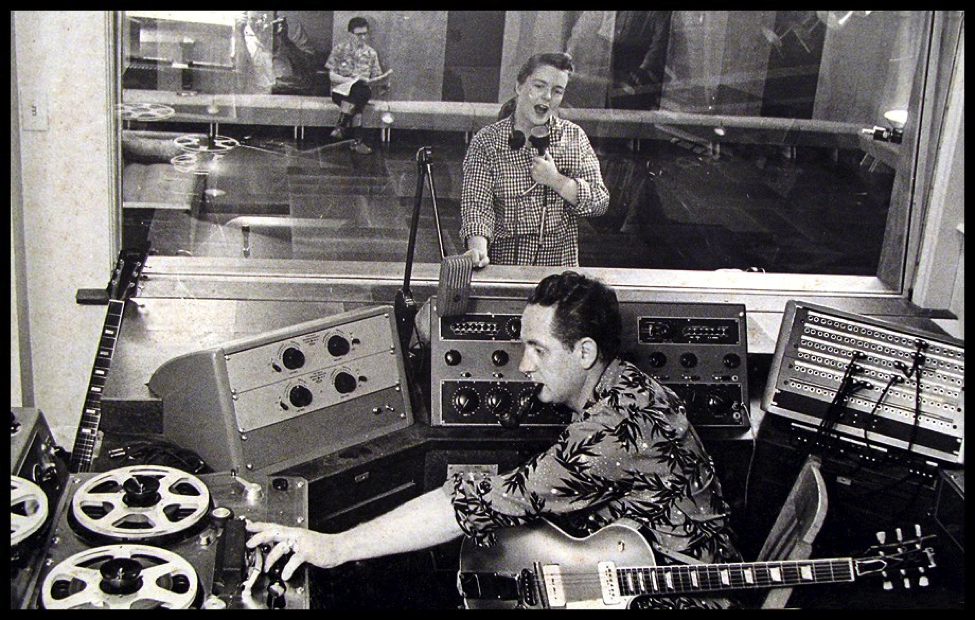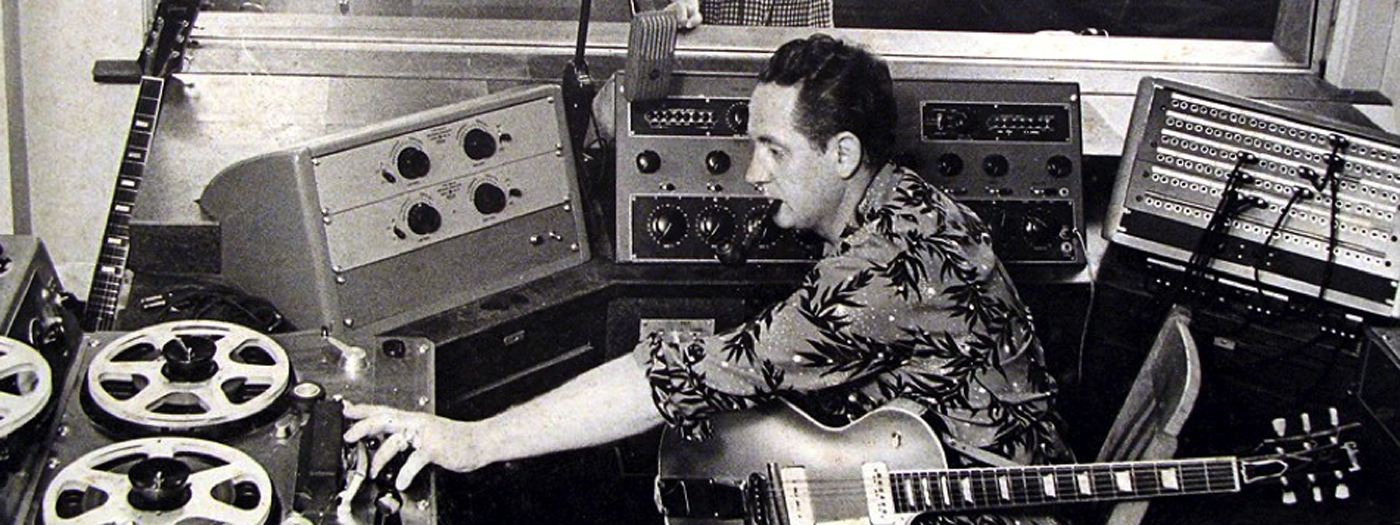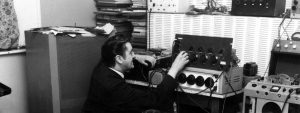Barry Cleveland: How Les Paul Created His Extraordinary New Sound
by Barry Cleveland
After secretly toiling away in his garage studio for many months, Les Paul emerged in late 1947 with the first two songs from a batch of extraordinary recordings embodying what became known as his “New Sound.” Paul’s uncanny arrangements of “Lover” and “Brazil” were created using a primitive form of multi-tracking—technically sound-on-sound recording—involving two modified cutting lathes, simple but brilliantly employed electronics, and a large quantity of blank acetate discs.
Paul played all the instruments on these “multiples,” as he referred to them, including drums and percussion, quasi bass, rhythm guitar, lead guitar, and several additional guitars that played back at double-speed and consequently were pitched an octave higher. These unprecedented recordings blew the minds of millions of people—industry professionals and lay listeners alike—upon their release in 1948.
By the time Paul went public with his New Sound, he had already been bouncing back and forth between a pair of disc-cutting lathes for a number of years. He would record one part using the first machine, and then play that recording back through a mixer while simultaneously monitoring the sound using headphones and playing a second part. The output of the mixer was routed to the second disc recorder, resulting in two layered “tracks” on a single disc. To record additional tracks, he would simply continue the process of bouncing back and forth, until he had everything he needed. Obviously, the more times he dubbed back and forth, the less distinct the original tracks would become, and the more noise and distortion would be added overall. Paul employed several ingenious devices and techniques to address those significant challenges.
Paul’s mixer was a 4-channel unit built by his friend Wally Jones. It was specifically designed to optimally match the input and output levels of the various pieces of gear, resulting in the quietest possible performance. The mixer’s guitar input fed a custom tube preamp with a 5kHz boost that added brightness and bite. High frequency loss was still a problem, however, as a result of the physical properties of the acetate discs themselves.
“As you got closer to the inside of the record, you would lose highs,” Paul told me when I interviewed him in 2001 (while researching my book, Joe Meek’s Bold Techniques). “I got around that by recording at 78rpm on the outside of a 17″ disc. That gave me a lot of room, and I was burning up those discs. That’s why the quality was so great. I was going at 78rpm with the EQ set for 33 1/3rpm.”
An additional high frequency issue encountered by Paul was the fact that after multiple bounces the tracks recorded earliest would sound progressively duller than the more recently recorded tracks, so he would adeptly calculate the rate of brightness loss on a given sequence of tracks and boost the highs upfront during recording to compensate. Another technique he employed to achieve maximum presence and clarity was to keep the signal as hot as possible without inducing distortion, which he accomplished by what might be thought of as manual limiting. The Wally Jones mixer was fitted with a decibel meter rather than the more typical VU meter, and Paul would eyeball it while playing, making minimal adjustments to his volume as necessary.
Recording the double-speed guitar parts required as much musical prowess as it did technical savvy. Paul ran both lathes at half speed while recording, which meant that he had to play along with backing tracks that were playing back at half speed and an octave lower. (Should you doubt the difficulty of getting the tempo and phrasing right while doing this, give it a try some time. Then, listen to, say, “Caravan” and “What Is This Thing Called Love” and imagine conceptualizing and playing all of those complex sped-up runs and harmonies.) Once the recording was returned to normal speed, the new guitar parts would play back twice as fast and an octave higher. And to simplify making the speed changes necessary to accomplish this, Paul had his lathes modified to run accurately at both 78rpm and 39rpm, and to easily switch between the speeds.
As astonishing as his deft track layering and high-speed accompaniment were, however, Paul had still more tricks up his sleeve, such as the delay effect on “Caravan” that he purportedly achieved by tapping the playback needle after the cutter head so that whatever had just been recorded would play back a moment later, and recording in reverse. Paul also claimed that he “would start the two cutters out together, and then just slow one down and speed it up ever so little” to create phasing and flanging effects, though doing that would presumably require having yet a third lathe to record to, and one is hard put to identify either effect on any of Paul’s acetate-disc recordings from that period.
In 1949, Paul’s New Sound was elevated to another level when his friend, mentor, and former employer Bing Crosby gave him an Ampex Model 300 reel-to-reel tape recorder—which he wasted no time in modifying. By adding another playback head before the existing erase, record, and playback heads (so that the part recorded initially was played back by the first head, and simultaneously dubbed to the record head as it fed headphones), he could make sound-on-sound recordings with a single machine. But although tape sounded much better than acetate discs, there was a daunting downside.
“The only drawback to this—which wasn’t a drawback as I look back—was that if you were recording 12 parts, and you blew the 11th part, you had to start all over,” explained Paul. “That makes you a pro. When [Paul’s wife and musical partner] Mary Ford and I made ‘How High the Moon,’ we had 11 parts down, and Mary is singing her last part, and I’m playing my last guitar part, and a plane goes over—back to number one.” Paul eventually acquired a second Model 300, and overcame that restriction by bouncing between the two tape recorders much as he had done previously with the two lathes.
Regardless of whether one or two recorders were used, however, the audio quality of the tracks that were recorded earliest would degrade significantly as new tracks were layered on top of them, necessitating recording the least-prominent parts first, and adding critical parts such as the “bass” (played on guitar), the main guitar, and the lead vocal last. This required Paul to establish a good musical feel while playing, say, the fourth guitar part rather than a primary part. He also had to have his typically complex arrangements worked out in advance, so that the many parts would work musically and dynamically in terms of how they sat in the final blend once many layers had been recorded, and the earliest layers had faded and become less distinct.

There was also the matter of keeping steady time, so that all of the overdubs remained synchronized. “I didn’t use a metronome,” said Paul. “I would just beat out the time by beating on the neck and strings of the guitar, and lay down a rhythm track, knowing that I’m going to bury that son of a bitch. But in burying it, it was adding that drive and momentum. You don’t realize that it is beating on the guitar, but it is there, and it plays an important role. I might lay three of those tracks down. I would use them way back at the beginning of 30 tracks.”
If “30 tracks” raised your eyebrows, consider that the number of tracks Paul claimed he recorded on any given song tended to increase over the years. For example, in various interviews, he said that there were as few as eight, and as many as 37 tracks on “Lover.” (In fairness, however, Paul’s propensity for embellishing the truth may have had as much to do with his being raised in Waukesha, Wisconsin as it did with anything else. Reputedly, telling “whoppers” was pretty much de rigueur for residents there at the time.)
Ironically, while Paul’s role in developing the world’s first 8-track reel-to-reel tape recorder (commissioned in 1952 and delivered by Ampex in 1955) is frequently cited as his most significant contribution to recording, every single track of his most extraordinary musical work—from the advent of his New Sound to the last of his million-selling hits with Mary Ford—was recorded on a mono tape machine or cut directly into an acetate disc.
Photo courtesy of The Les Paul Foundation

Barry Cleveland is a Los Angeles-based guitarist, recordist, composer, music journalist, and editor-in-chief of Model Citizens and The Lodge, as well as the author of Joe Meek’s Bold Techniques and a contributing author to Stompbox: 100 Pedals of the World’s Greatest Guitarists. Barry also served as an editor at Guitar Player magazine for 12 years and is currently the Marketing Communications Manager at Yamaha Guitar Group. barrycleveland.com
Related posts
Leave a Reply
You must be logged in to post a comment.
By submitting your details you are giving Yamaha Guitar Group informed consent to send you a video series on the Line 6 HX Stomp. We will only send you relevant information. We will never sell your information to any third parties. You can, of course, unsubscribe at any time. View our full privacy policy




Barry Cleveland, you’re article and humanity says it all, thank you SO MUCH for all you do for musicians and the music industry! Line6 Helix Native/Helix Floor/Variax has changed the way I make, record and produce music forever…Rock On! Mark Roos https://cuttingroommusic.com/